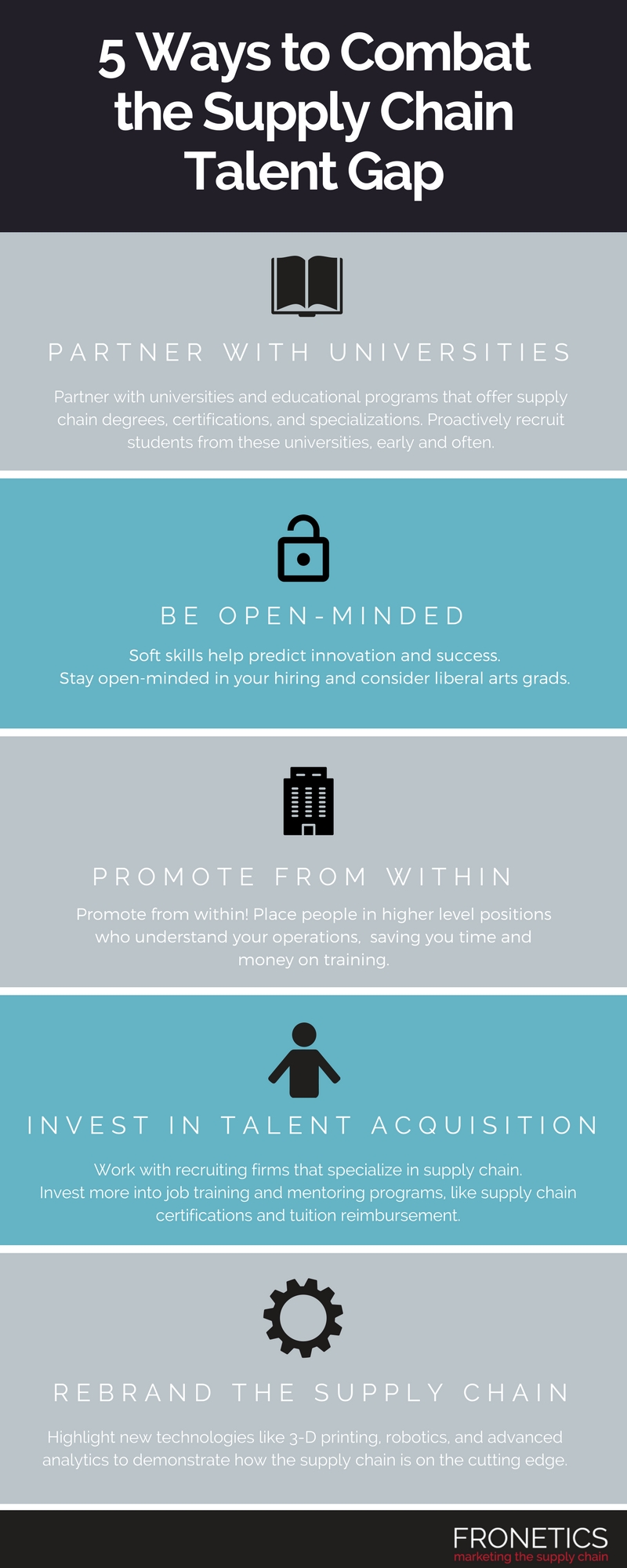
by Fronetics | May 15, 2018 | Blog, Content Marketing, Current Events, Logistics, Marketing, Supply Chain, Talent
Use these 5 strategies to overcome the supply chain talent gap, filling critical positions with qualified hires and streamlining processes for future talent.
The U.S. Bureau of Labor Statistics projects the number of supply chain management and logistics jobs will increase 26% from 2010 to 2020. That means, in the near future, for every five to 10 job openings, there is one qualified applicant. These are the kind of odds you hope for in Vegas, but not if you’re looking to fill positions, and quickly.
[bctt tweet=”One-third of supply chain and logistics companies have taken zero steps to create or feed their future talent pipeline.” username=”Fronetics”]
It’s no secret — the supply chain is experiencing a major talent gap. In fact, in a recent DHL survey nearly 70% of survey respondents list “perceived lack of opportunity for career growth” and “perceived status of supply chain as a profession” as having a high or very high impact on their ability to find, attract, and retain talent. What’s even more interesting is that one-third of supply chain and logistics companies have taken zero steps to create or feed their future talent pipeline. Don’t be one of those companies!
Let’s face it: Many don’t perceive supply chain and logistics as a sexy profession. But there are real benefits for people that get into the industry. Cutting-edge technology, career growth, and environmental impact are just the tip of the iceberg. There are ways to showcase all the industry has to offer, giving you qualified hiring options and helping manage processes for future talent.
These five strategies will not only help you start hiring supply chain talent quickly, but will also help you implement processes for prospective positions.
5 strategies for overcoming the supply chain talent gap

(Made with Canva)
Takeaway
The supply chain talent shortage is a hurdle, but not a deterrent. Companies need to step up their game when it comes to finding and retaining qualified candidates. Along with these strategies, highlighting your brand’s unique value and culture will make it stand out as an exciting place to work.
How is your company combating the supply chain talent gap?
Related posts:


by Fronetics | Oct 19, 2017 | Blog, Leadership, Strategy, Talent
Investing in your employees through wages, time and energy can have a big impact on your company’s productivity.
Successful companies understand that employees’ job satisfaction and engagement affect productivity. After all, employees are an extension of your business. Keeping them challenged and encouraged is key to their success, as well as the overall success of your company. In research for their book, Time, Talent, and Energy, Bain partners Michael Mankins and Eric Garton discovered that investing in your employees does, in fact, pay off for companies. “The top-quartile companies in our study unlocked 40% more productive power in their workforce through better practices in time, talent and energy management,” says Garton.
Here are the 3 investments that Mankins and Garton found most impactful to productivity.
3 investments that will invigorate productivity
1) Wages
Three economists studied OECD data representative of the whole population of businesses in 16 countries around the world. They found that firms paying higher wages were reporting higher productivity. The link between the two seems pretty basic: Pay workers higher wages and they will feel valued and be more productive at their jobs.
But many companies believe that higher wages come at the cost of their consumers. This doesn’t have to be the case. Dan Teran, chief executive of Managed by Q, is a thought leader in higher wages creating a culture of respect and productivity.
“Teran believes that most American businesses, and especially fast-growing start-ups like Uber, have mistaken short-term gains for long-term value, undercutting the share of revenue that flows to workers in a way that will perversely hurt their bottom line. He believes, even more radically, that decades of rising inequality and stagnant wages in America are not an inevitable byproduct of capitalism; instead, they come from a simple misunderstanding about how best to deploy workers and recognize the value they bring to a company.” Managed by Q’s ‘Good Job’ Gamble, Adam Davidson
From small businesses like Managed by Q to retail giants like Walmart, the ideology behind better wages and benefits is catching on. Companies are understanding the relationship between production and pay and trying to narrow the gap.
2) Time
The pressure of working long hours and being available around the clock has a lasting effect on employees. Such practices often lead to burnt out, overworked team members. In fact new research suggests that, on average, managers have fewer than 7 hours per week of uninterrupted time to do deep work. Their days are filled with meetings, responding to emails, and having short increments of time to complete tasks.
The average company loses more than 25% of its productive power to organizational drag, processes that waste time and prevent people from getting things done. Meetings that last too long and processes that move too slowly contribute to lower productivity, less quality work, and low employee morale.
Allowing employees the time to feel creative and focused on their projects will lead to breakthroughs in productivity. Try establishing quiet hours for certain times of the day to encourage workers to spend more uninterrupted time deep thinking, which can lead to innovative and fresh ideas.
3) Energy
An inspired employee is more than twice as productive as a satisfied employee and more than three times as productive as a dissatisfied employee. Yet, only one in eight employees are inspired. One of the most beneficial things a company can do is to inspire its employees. Engaged working environments and positions that allow creative and innovative thought will lead to increased employee engagement and productivity.
Companies like Apple, Netflix, Google and Dell are 40% more productive than the average company. Why is that, you ask? These companies invest in inspiring their employees.
“Inspirational leadership can be taught. Companies that recognize that and invest in making it happen create meaningful impact on the productivity of their company,” says Mankins. Studies have shown that employees that feel satisfied with their jobs are more productive.
Give your employees the autonomy to feel engaged in their work. This freedom will give them the opportunity to get creative and involved in their projects.
The opportunity exists for all employers to positively affect worker happiness while simultaneously increasing productivity. If your company is interested in exploring the benefits of investing in their employees, focusing on wages, time and energy is a good place to start. You might be surprised to find currently untapped financial gains just by putting investment in your employees at the top of your priority list.
Related posts:


by Jennifer Hart Yim | May 30, 2017 | Blog, Logistics, Supply Chain, Talent
Is the Supply Chain talent gap problem really a talent management problem?
This guest post comes to us from Argentus Supply Chain Recruiting, a boutique recruitment firm specializing in Supply Chain Management and Procurement.
As a recruitment company completely specialized in Procurement and Supply Chain, we’re interested in following the so-called “talent deficit” in the field from all angles and perspectives. The fact is, it’s becoming harder for companies for find the talent that they need for these positions as baby boomers retire and the function evolves. As trade publication Supply Chain 24/7 puts it, “study after study has shown that for every new Supply Chain Manager entering the workforce, two (or more) are retiring.”
It’s a serious issue.
But the more you look at this issue, and the more perspectives you seek, the more you realize how complex it truly is: We’re witnessing a generational shift in the Supply Chain industry whereby more young people are entering the field. Technology has developed rapidly over the past 10 years, with big data, 3-D printing, Blockchain and automation promising to upset the apple cart completely over the next 10. It’s not just that people are retiring. It’s that finding people who have a depth of understanding of how to harness these new technologies is going to be a major driver of company competitiveness over the coming years, and they’re hard to find.
That growing demand is part of what makes Supply Chain such an attractive field for young people who are interested in business that combines global exposure, strategic problem solving, technology, and data. More universities and colleges are offering Supply Chain Management programs. But the skills required are always evolving, and how can the industry ensure that people are adequately skilled when they themselves can’t always predict the technological picture 3-5 years down the road?
Lack of talent management?
There was a thought-provoking blog post on this topic in Supply Chain Management Review this week by Supply Chain Professor Michael Gravier. Titled, “Lack of Supply Chain Talent – or Lack of Talent Management?”, the post talks about the talent deficit from the perspective of someone who’s very much in the trenches of preparing tomorrow’s Supply Chain leaders for tomorrow’s workforce.
Professor Gravier’s point is pretty simple, but pointed: “Young people who go into Supply Chain and manufacturing jobs complain that employers demand creativity during the hiring process, yet have no tolerance for new ideas in the workplace.”
In other words, companies are eager to lock down the highest-potential candidates — which only makes sense because of course you want the best talent, and of course you don’t want that talent going to your competitors. But once those candidates are placed? In Gravier’s eyes, organizations don’t necessarily take the next step and let them contribute in a creative way. For Gravier, millennial workers — especially high performers — specifically demand a higher level of engagement and skill growth than employers might be accustomed to. And, by putting these new workers in transactional roles without much opportunity for growth, companies are jeopardizing their long-term talent goals and putting themselves in danger of falling behind.
As Gravier puts it: “There’s evidence that companies show little commitment to developing and rewarding needed skills, and companies hire top-notch graduates in order to avoid having to deal with people problems later, which shows that there’s likely insufficient training and support as personnel move into supervisory positions.”
The reality for Supply Chain
A few things are worth mentioning from our perspective: for one, there’s always going to be a low person on the totem pole at any company. Workers have always had to “pay their dues” for the first couple years of their career, no matter the field, whether it’s doing dishes or preparing purchase orders. So it’s a bit unreasonable for recent Supply Chain grads to expect highly strategic roles right out the gate. For another, it makes sense for companies to want to hire the best people now, even if it means putting them in roles where they might not be developing as quickly as they would like?
On the other hand, if companies truly want to get ahead of their competitors, doesn’t it make sense to put resources into training, mentorship and skills development?
Whatever you make of his argument, it’s pretty easy to agree on one thing: Companies need to do all they can not only to attract great candidates, but to help them thrive and grow — both to keep those candidates’ eyes from wandering other opportunities, and to unlock the innovation that these candidates can provide.
But what do you think? Are companies developing junior prospects in Supply Chain well, or leaving them in entry-level positions for too long? Are you near the beginning of your career? Or does your company hire a lot of junior Supply Chain staff? Let us know in the comments!

by Fronetics | May 9, 2017 | Blog, Leadership, Talent
Employers that can reduce stresses surrounding childcare increase their chances of retaining their most talented employees.
Many companies struggle with attracting and, more importantly, retaining their best employees. There are many reasons why, of course. But one of them that we don’t talk enough about in the supply chain — though it’s been gaining national attention lately — is the issue of childcare.
This is a very personal matter to me, a working mother who struggled to find a balance between the cost of childcare and the price of my employment. And that doesn’t even cover the emotional, physical, and logistical challenges of finding somewhere to deposit young children for a good portion of the day while you earn a paycheck. But I digress…
The staggering cost of childcare
According to Care.com, the national average for at-home care is $28,354 per year, while in-center care is $8,589 per year. These numbers are often staggering to parents, who are not physically or emotionally ready to part with their newborns after a short, and for most, unpaid maternity or paternity leave.
It’s Working Project and Forty Weeks founder Julia Beck recently wrote about concerns parents consistently face when heading back to work after having a baby. At the top of the list is childcare and a general lack of support from the workplace. “Support from employers makes or breaks the deal, creating either a manageable new reality or the need for a backup plan (or even an exit),” she writes.
Don’t believe that’s true? Take a look at this statistic: 83% of millennials would leave their jobs for one with better family care benefits. As millennials represent an increasing percentage of the supply chain fabric, it’s a concern that should increasingly matter to employers.
Here’s the good news: Every challenge employees face is an opportunity for employers to gain a leg up on their competition for talent. Easing the stresses surrounding childcare can be a simple yet significant way that companies can support their most talented employees, who also happen to be working parents.
How employers can ease childcare stresses for working parents
So what can your company do to help make work/life balance more obtainable for your employees? Here are three practical suggestions that are fairly simple for employers to implement but that might make a world of difference for working parents.
1) Make schedules predictable.
When a parent learns of a last-minute, late-afternoon meeting, they must scramble to find someone to pick up their son or daughter from daycare, miss a long-anticipated school or sporting event, or otherwise come up short on time promised to their families. Setting rules around scheduling meetings can help avoid this additional stress on parents.
For example, some organizations have a policy that no meetings can start before 9:30am or after 4:30pm, so parents don’t have to worry about drop-off or pick-up with daycare facilities. Allowing parents to focus on work and not worrying about running late for soccer practice makes them more productive employees.
2) Offer flexibility.
BirchBox’s VP of People and Culture, Melissa Enbar, explains that her organization offers flexibility around the hours employees work and the location they work from.
Nowadays most jobs can be effectively performed from home or another location. This is a luxury that makes sense for working parents — and it’s an opportunity for companies to offer an extra benefit for employees who want or need to set their schedules around their families.
3) Aid in childcare options.
Whether your company offers on-site care or not, you can still help ease the stress of finding reliable and affordable childcare for your employees.
A good starting point is creating resources for new parents beginning their childcare search. This can be as simple as posting a list of childcare facilities recommended by other employees or as in depth as offering backup childcare options for emergency situations. Brigham and Women’s Hospital in Boston, for example, offers a reduced rate for six days of emergency care at home through Care.com, plus access to a backup child care center, according to one employee.
Let’s face it, securing a safe, nurturing childcare option is a challenge for all working parents. When they are plagued by related stresses — such as an unforeseen late meeting, illness, or other everyday concern — parents aren’t able to give their full attention to their job. This comes at a cost to the employee and ultimately, the business.
There are things you, as an employer, can do to make working for your company more appealing to parents. Helping employees navigate childcare stresses will be benefit not only the individual, but the company as well, in terms of employee retention. After all, a flexible-hours or no-4 p.m.-meetings policy may be the differentiator that keeps your talent working for you rather than your competitors.
Related posts:

by Fronetics | Apr 26, 2017 | Blog, Logistics, Supply Chain, Talent
Investing in your top talent and playing an active role in developing their careers will motivate them to stay around.
Company loyalty is a thing of the past. In today’s day and age, everyone is looking for the next best thing, and that is true in the workplace as well. But this doesn’t mean that retention of top talent is hopeless.
Accenture conducted a cross-industry study and determined the top four reasons employees quit their jobs:
- Lack of recognition (43%)
- Internal politics (35%)
- Lack of empowerment (31%)
- Don’t like boss (31%)
Companies have work to do to create a positive workplace experience, where employees feel challenged and valued. So where do you begin? Retaining top talent can be challenging, but it is possible. Here are three tips for keeping your top talent around longer.
Treat them as individuals
This seems like a pretty basic rule. But if you think about it, top management often gets treated as an elite group. Often times these talented members of your company spend their careers trying to be innovative and cutting edge, so it’s important for them to feel like they are valued and unique. Roger L. Martin, former dean of the Rotman School of Management at the University of Toronto, offers a relevant anecdote:
A top consultant, one of the firm’s 15 or so global account managers, approached me to ask for paternity leave (a benefit that’s now fairly standard, but 20-odd years ago was rare). I readily replied, “Sure. You’re a GAM. At your level, you can do pretty much whatever you want.” He said “OK,” and walked off, looking sullen. I was taken aback: He had asked for something, and I had given it to him. … This consultant wanted to hear: “We care about you and what you need. If paternity leave is the thing that is particularly important to you, we support you 100%.”
Martin witnessed first-hand the effects of treating this manager as part of a class, instead of as an individual. Stepping back and realizing that top talent need to be treated as individuals can add to their feeling valued within your company.
Develop from within
As more money and talent flood into the supply chain, it will be important to avoid the Silicon Valley problem of poaching, or employees leaving for larger salaries elsewhere. Investing in current employees in a meaningful, attentive way could make all the difference.
Think about your rising stars’ futures and next steps within your company. They probably have a plan, and you should as well. Make sure those plans align, and be open to assisting their journey to meet their goals.
Ask specific questions about what it takes to create the environment that would help encourage your talent’s best performance. Ask what works, and also ask what doesn’t work. Be specific and ask what causes your talent anxiety or stress. Investment is a big part of development. It helps talent feel like part of a bigger picture. If you invest in them, they will invest in you.
Encourage flexibility
Gone are the days of strict office hours, and in its place are flexibility and mobility for the workplace.
When companies allow their employees some flexibility, they become happier and more productive. With technology at our fingertips, and all the options that provides, employees expect to work from a location of their choosing, whether it be home, a library, or a coffee shop. Millennials rank this kind of flexibility highly among factors that make companies appealing places to work.
Don’t sit back and assume your employees are willing to be passive about their careers. See your employees as assets. Have a strategy. Be part of their team, and make them part of yours. See their talent and invest in them. Otherwise they’ll find another supply chain company that will.
Related posts:










